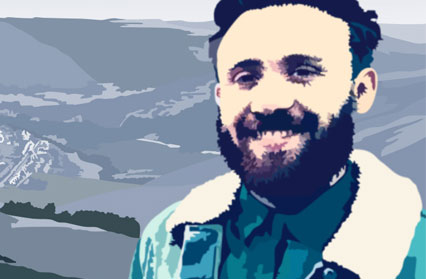Rhys Milsom lives in Roath, Cardiff, with his girlfriend and two cats. He grew up in the Rhondda Valley and has a BA in Creative & Professional Writing from the University of Glamorgan (now known as the University of South Wales) and an MA in Creative Writing from the University of Wales: Trinity Saint David. He is the editor of www.wicid.tv – a website for young people aged 11-25 in Rhondda Cynon Taff, which showcases creative writing, poetry, photography, films, reviews and events. The website is also specifically designed for young people to make their first steps into the creative industries. His fiction and poetry has been widely published in magazines, anthologies and websites.
John Lavin: ‘I’ll See You On Sunday, James’ is a very moving short story that also feels deeply personal. Is it a purely fictional piece or is it rooted in actual events?
Rhys Milsom: The short story itself is first and foremost a piece of fiction. However, the events that happen within the story are real and are fragments of some of the most clear and embedded memories I have of my childhood. James is an actual person and we really were as close as the story has hopefully depicted, but we grew apart in our early teens. The theme of a friend passing away was an amalgamation of my thoughts on drifting away from childhood friendships, which leads to complete loss of contact usually, and of what goes through your head when a friend goes missing for a few days due to heavy use of mephedrone, when they’re in their late 20s, which is another event that really happened.
‘I’ll See You On Sunday, James’ begins with a long, pharmaceutical description of mephedrone and closes with a poem. The words in-between are written in a very intense, personal manner, in memory of the James of the title. What was the thinking behind the style and architecture of the piece?
I’ve always loved short, sharp writing. I really enjoy it when a writer almost spits the words at you from the page. Writing, in that style, has an immediacy – I feel – that throttles you to read on. The description of mephedrone was placed at the beginning for two reasons: the first reason being that I wanted the reader to get a cold and realistic feeling of the drug and its effects through a detailed and ingredient-like description and for them to understand how dangerous the drug is. I was also re-reading some Easton Ellis at the time, and the particular piece of writing of his had long-winded descriptions but then he’d whack the reader full in the face with a hard-hitting sentence which – I guess – was used to remind the reader the narrator was still there.
The second reason was that I wanted the reader to be lulled into a false sense of security, due to the long-winded description, and for the first sentence of the story – ‘In May 2010, my best friend committed suicide after three slow years of addiction had become too much for him to bear.’ – to hit them instantly and to provide a factor which urged them to read on. I felt I was addressing the reader and James personally, as if I was in conversation with them at the pub, which is another style of writing I admire.
With regards to the poem, I had an image in my head of a gravestone with some form of poetry etched in and another image of myself reading a poem at the funeral. It just so happened that I was working on a poem at the time of writing the short story, and I felt it fitted perfectly.
The stylistic inventiveness on display here reminded me a little of American ‘hysterical realist’ authors like Dave Eggers and Jonathan Franzen. Would I be right to think that writers from this school have been an influence on you? And if not, are there any writers that you might consider to have been a particular source of inspiration to you?
Eggers and Franzen have been an influence, yes, but I think their influence was more of a sub-conscious aspect rather then myself being alert to their styles at the time of writing. I wouldn’t say they’re writers that have directly influenced me, but their writing has respectively played a part in my writing. I haven’t read them for years but, I suppose, when a particular style of writing influences your early work, they’ll always be there nagging you to utilise their form and, maybe, this is what happened here.
Writers that have been an immediate source of inspiration are Hubert Selby Jr., Bret Easton Ellis, Irvine Welsh, Craig Clevenger, Charles Bukowski, Niall Griffiths and Joseph Roth. All of these writers bring something different to their writing, but they focus on real-life events, people and places and manage to twist some fiction in. This, I feel, is intriguing to the reader – is the story real or not?
The story is concerned with a childhood and adolescence spent growing up in Rhondda Cynon Taff. It’s obviously an area that is very close to your heart as you work for Wicid.tv, a website specifically designed to help foster creativity among 11-25 years olds in Rhonda Cynon Taff. Could you tell us a little bit about this project?
Wicid.tv is a new media and information website specifically designed for young people aged 11-25 in Rhondda Cynon Taff. The project sits within RCT council’s Youth Engagement and Participation team. Young people can sign up to the website to express anything creative – poetry, reviews, art, videos, short stories, digital media – which I, as editor, then edit and publish onto the site. Wicid has over 2,500 young people signed up (who are all from RCT) who regularly submit content. Wicid is also a platform for young people to make their first steps into the creative industries, with some of the young people gaining experience and jobs out of the project. As part of my role, I travel around RCT to youth provisions where I deliver accredited courses in poetry and creative writing. I firmly believe that every young person should have access to express their creativity, regardless of their background, and that is what Wicid directly allows.
Do you have a particular writing routine?
To be honest, no. I know a lot of writers who sit down every day and try to write a certain amount of words but that isn’t how I work. I tend to mull over ideas for a few days and then write the story or poem down bit by bit. I’ve found that when I try to write every day, I become really unhappy with what I’ve produced so I have to play out scenes in my head and juggle with words and plots before writing anything down. I suppose I’m a bit stubborn with adhering to a ‘writer’s code’ that so many people hold dear.
Camus said that, ‘art is nothing but this slow trek to discover, through the detours of art, those two or three great and simple images in whose presence his heart first opened.’ Would you agree, and if so do you have ‘two or three’ such images yourself?
I definitely agree. I suppose I’m taking this a bit literally but images that always inspire me to write are: the streets and people of the valleys – especially in winter; a jostling pub where people are shadows hidden behind a wall of cigarette smoke and where sticky pint glasses crowd empty, wooden, chipped tables and voices merge and rip over each other which leaves a hubbub of intangible drone; and another image which inspires me is the family home, where I first started writing. I now live away, but that image of my home always settles my thoughts, cosied in a corner of Penygraig with a view of the valley behind it and the dog greeting me as I open the door.
Finally, you’ve been working on a novel, Free Falling. From what I’ve read it’s a very fast-paced, sharply observed piece that is concerned with the grittier side of life in South Wales, as well as perceived notions of masculinity. Could you give us a little bit more information about what seems to me to be a very promising work?
Free Falling began during my BA in the University of Glamorgan (now known as the University of South Wales) where I received great tutoring from Tiffany Murray and Chris Meredith who first encouraged me to write more. The novel continued during my MA in University of Wales: Trinity Saint David, where Menna Elfyn helped me greatly with the structure and characterisation aspects.
Free Falling is based loosely on real events, places and people; where the characters are informed freely by my friends. Some of the plot really happened, other parts are, in fact, fiction. The style is similar to ‘I’ll See You On Sunday, James’, but the vernacular and plot are completely different. The story focuses on a group of friends, who live in Cardiff, and it details their downfall – and rise – through drug-use, drug-pushing, heavy drinking, sex, sexuality realisations and violence. Real places are used, such as pubs and clubs, and some of the stories are based on genuine events that I’ve witnessed.
Free Falling is a novel about waste, confusion, loss, life, and gives a real insight into what it’s like to be an adolescent drug addict while your friends grow up and grow away from you.
The novel is halfway finished and I hope to complete it by summer 2015.
original illustration by Dean Lewis












